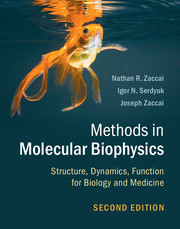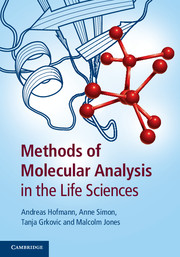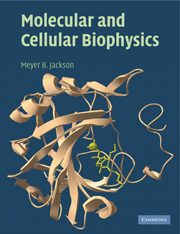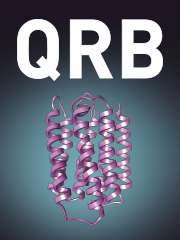Methods in Molecular Biophysics
Structure, Dynamics, Function for Biology and Medicine
2nd Edition
£54.99
- Authors:
- Nathan R. Zaccai, University of Cambridge
- Igor N. Serdyuk, Formerly of the Institute of Protein Research, Pushchino, Moscow Region
- Joseph Zaccai, Institut Laue-Langevin
- Date Published: May 2017
- availability: In stock
- format: Hardback
- isbn: 9781107056374
£
54.99
Hardback
-
Current techniques for studying biological macromolecules and their interactions are based on the application of physical methods, ranging from classical thermodynamics to more recently developed techniques for the detection and manipulation of single molecules. Reflecting the advances made in biophysics research over the past decade, and now including a new section on medical imaging, this new edition describes the physical methods used in modern biology. All key techniques are covered, including mass spectrometry, hydrodynamics, microscopy and imaging, diffraction and spectroscopy, electron microscopy, molecular dynamics simulations and nuclear magnetic resonance. Each method is explained in detail using examples of real-world applications. Short asides are provided throughout to ensure that explanations are accessible to life scientists, physicists and those with medical backgrounds. The book remains an unparalleled and comprehensive resource for graduate students of biophysics and medical physics in science and medical schools, as well as for research scientists looking for an introduction to techniques from across this interdisciplinary field.
Read more- Provides comprehensive coverage and up-to-date treatment of the full range of physical methods used in current biological research as well as in medical physics, illustrated using real-world examples
- Each method includes a brief historical introduction, theoretical principles, applications, advantages and limitations, and concludes with a checklist of key ideas that summarize the important points for students
- Includes all the necessary background to ensure accessibility for biologists, physicists, and those with medical backgrounds
Reviews & endorsements
Review of first edition: '… a valuable contribution to the field. … There is nothing quite like it at the moment.' Sir Tom Blundell FRS, University of Cambridge
See more reviewsReview of first edition: … one of the most comprehensive and highly relevant texts on biophysics that I have encountered in the last 10 years, clearly written and up-to-date … a must-have for biophysicists working in all lines of research …' Nikolaus Grigorieff, Brandeis University, Massachusetts
Review of first edition: '… a wonderful up-to-date treatise on the many and diverse methods used … in the fields of molecular biophysics, physical biochemistry, molecular biology, biological physics and the new and emerging field of quantum nanobiology.' Karl J. Jalkanen, Quantum Protein Centre, Technological University of Denmark
Review of first edition: '… a valuable resource for novice and seasoned biophysicists alike.' Dan Minor, California Institute for Quantitative Biomedical Research, University of California
Review of first edition: '… the book I consult first when faced with an unfamiliar experimental technique. Both classic analytical techniques and the latest single-molecule methods appear in this single comprehensive reference.' Philip Nelson, University of Pennsylvania and author of Biological Physics
Review of first edition: '… valuable both for students and research scientists.' Michael G. Rossmann, Hanley Professor of Biological Sciences, Purdue University
Review of first edition: 'A great achievement … awaits the student who reads this book … an excellent reference for the seasoned practitioner of biophysical chemistry.' Milton H. Werner, The Rockefeller University
Review of first edition: 'This well written, thorough, and elegantly illustrated book provides the connections between molecular biophysics and biology that every aspiring young biologist needs.' Stephen H. White, University of California at Irvine
Review of first edition: '… I enthusiastically recommend Methods in Molecular Biophysics to anyone who wishes to know more about the techniques by which the properties of biological macromolecules are determined.' David Worcester, University of Missouri
Review of first edition: 'A book that teaches the methods well, creates the intellectual framework of our understanding, and can guide the field. Earlier efforts by Cohn and Edsall, Tanford, Edsall and Wyman, and Cantor and Schimmel have served this important purpose in the past, but the advance of time and technology has diluted the force of these classic works in contemporary Biophysics, both in the teaching and the practices of the field. How welcome, then, a clearly written, thoughtful and modern text that will serve well, both in formal courses and as a reference. The authors have built each method from its fundamental premises and principles, have successfully covered an impressive span of topics, and will be rewarded by attention from an audience that hungers for the next defining text in Molecular Biophysics.' D. M. Engelman, Yale University, New Haven
Customer reviews
Not yet reviewed
Be the first to review
Review was not posted due to profanity
×Product details
- Edition: 2nd Edition
- Date Published: May 2017
- format: Hardback
- isbn: 9781107056374
- length: 702 pages
- dimensions: 283 x 224 x 40 mm
- weight: 2.19kg
- contains: 825 b/w illus.
- availability: In stock
Table of Contents
Preface to the first edition
Preface to the second edition
Introduction
Part I. Biological Macromolecules and Physical Tools:
1. Macromolecules in their environment
2. Macromolecules as physical particles
3. Understanding macromolecular structures
Part II. Mass Spectrometry:
4. Mass and charge
5. Structure function studies
Part III. Thermodynamics:
6. Thermodynamic stability and interactions
7. Differential scanning calorimetry
8. Isothermal titration calorimetry
9. Surface plasmon resonance and interferometry-based biosensors
Part IV. Hydrodynamics:
10. Biological macromolecules as hydrodynamic particles
11. Analytical ultracentrifugation
12. Fluorescence depolarization
13. Dynamic light scattering and fluorescence correlation spectroscopy
Part V. Optical Spectroscopy:
14. Visible and IR absorption spectroscopy
15. Two-dimensional IR spectroscopy
16. Raman scattering spectroscopy
17. Optical activity and circular dichroïsm
Part VI. Optical Microscopy:
18. Light microscopy
19. Single molecule manipulation and atomic force microscopy
20. Fluorescence microscopy
21. Single-molecule detection
22. Single-molecule manipulation
Part VII. X-Ray and Neutron Diffraction:
23. The macromolecule as a radiation scattering particle
24. Small-angle scattering and reflectometry
25. X-ray and neutron macromolecular crystallography
Part VIII. Electron Diffraction:
26. Electron microscopy
27. Three-dimensional reconstruction from two-dimensional images
Part IX. Molecular Dynamics:
28. Energy and time calculations
29. Neutron spectroscopy
Part X. Nuclear Magnetic Resonance:
30. Distances and angles from frequencies
31. Experimental techniques
32. Structure and dynamics studies
Part XI. Medical Imaging:
33. Radiology and positron emission tomography
34. Ultrasound imaging
35. Magnetic resonance imaging
References
Index of eminent scientists
Subject index.
Sorry, this resource is locked
Please register or sign in to request access. If you are having problems accessing these resources please email [email protected]
Register Sign in» Proceed
You are now leaving the Cambridge University Press website. Your eBook purchase and download will be completed by our partner www.ebooks.com. Please see the permission section of the www.ebooks.com catalogue page for details of the print & copy limits on our eBooks.
Continue ×Are you sure you want to delete your account?
This cannot be undone.
Thank you for your feedback which will help us improve our service.
If you requested a response, we will make sure to get back to you shortly.
×





